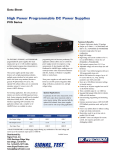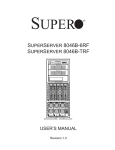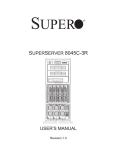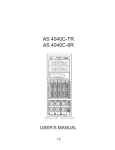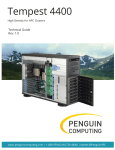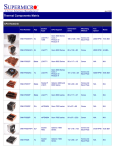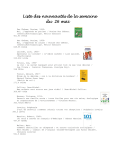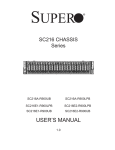Download Supermicro 748TQ-R1400B
Transcript
SUPER
®
SC748 Chassis Series
SC748TQ-R1000(B)
SC748TQ-R1200(B)
SC748S-R1000(B)
USER’S MANUAL
1.0
SC748 Chassis Manual
The information in this User’s Manual has been carefully reviewed and is believed to be accurate.
The vendor assumes no responsibility for any inaccuracies that may be contained in this document,
makes no commitment to update or to keep current the information in this manual, or to notify any
person or organization of the updates. Please Note: For the most up-to-date version of this
manual, please see our web site at www.supermicro.com.
Super Micro Computer, Inc. ("Supermicro") reserves the right to make changes to the product
described in this manual at any time and without notice. This product, including software, if any,
and documentation may not, in whole or in part, be copied, photocopied, reproduced, translated or
reduced to any medium or machine without prior written consent.
IN NO EVENT WILL SUPERMICRO BE LIABLE FOR DIRECT, INDIRECT, SPECIAL, INCIDENTAL,
SPECULATIVE OR CONSEQUENTIAL DAMAGES ARISING FROM THE USE OR INABILITY TO
USE THIS PRODUCT OR DOCUMENTATION, EVEN IF ADVISED OF THE POSSIBILITY OF
SUCH DAMAGES. IN PARTICULAR, SUPERMICRO SHALL NOT HAVE LIABILITY FOR ANY
HARDWARE, SOFTWARE, OR DATA STORED OR USED WITH THE PRODUCT, INCLUDING THE
COSTS OF REPAIRING, REPLACING, INTEGRATING, INSTALLING OR RECOVERING SUCH
HARDWARE, SOFTWARE, OR DATA.
Any disputes arising between manufacturer and customer shall be governed by the laws of Santa
Clara County in the State of California, USA. The State of California, County of Santa Clara shall
be the exclusive venue for the resolution of any such disputes. Super Micro's total liability for
all claims will not exceed the price paid for the hardware product.
FCC Statement: This equipment has been tested and found to comply with the limits for a Class
A digital device pursuant to Part 15 of the FCC Rules. These limits are designed to provide
reasonable protection against harmful interference when the equipment is operated in a commercial
environment. This equipment generates, uses, and can radiate radio frequency energy and, if not
installed and used in accordance with the manufacturer’s instruction manual, may cause harmful
interference with radio communications. Operation of this equipment in a residential area is likely
to cause harmful interference, in which case you will be required to correct the interference at your
own expense.
California Best Management Practices Regulations for Perchlorate Materials: This Perchlorate
warning applies only to products containing CR (Manganese Dioxide) Lithium coin cells. “Perchlorate
Material-special handling may apply. See www.dtsc.ca.gov/hazardouswaste/perchlorate”
WARNING: Handling of lead solder materials used in this
product may expose you to lead, a chemical known to
the State of California to cause birth defects and other
reproductive harm.
Manual Revision 1.0
Release Date: September 11, 2008
Unless you request and receive written permission from Super Micro Computer, Inc., you may not
copy any part of this document.
Information in this document is subject to change without notice. Other products and companies
referred to herein are trademarks or registered trademarks of their respective companies or mark
holders.
Copyright © 2008 by Super Micro Computer, Inc.
All rights reserved.
Printed in the United States of America
ii
Preface
Preface
About This Manual
This manual is written for professional system integrators and PC technicians. It
provides information for the installation and use of the SC748 4U chassis. Installation and maintenance should be performed by experienced technicians only.
Supermicro’s SC748 4U chassis features a unique and highly-optimized design
for dual-core Xeon platforms. The chassis is equipped with a redundant 1000 or
12000 Watt high-efficiency power supply for superb power savings. 3 hot-swappable
high-performance fans provide ample optimized cooling for the chassis and 5 hotswap drive bays and 3 peripheral drive bays offer maximum storage capacity in a
4U form factor.
This document lists compatible parts available when this document was published.
Always refer to the our Web site for updates on supported parts and configurations.
iii
SC748 Chassis Manual
Manual Organization
Chapter 1: Introduction
The first chapter provides a checklist of the main components included with this
chassis and describes the main features of the SC748 chassis. This chapter also
includes contact information.
Chapter 2: System Safety
This chapter lists warnings, precautions, and system safety. You should thoroughly
familiarize yourself with this chapter for a general overview of safety precautions
that should be followed before installing and servicing this chassis.
Chapter 3: Chassis Components
Refer here for details on this chassis model including the fans, bays, airflow shields,
and other components.
Chapter 4: System Interface
Refer to this chapter for details on the system interface, which includes the functions
and information provided by the control panel on the chassis as well as other LEDs
located throughout the system.
Chapter 5: Chassis Setup and Maintenance
Refer to this chapter for detailed information on this chassis. You should follow the
procedures given in this chapter when installing, removing, or reconfiguring your
chassis.
Chapter 6: Rack Installation
Refer to this chapter for detailed information on chassis rack installation. You should
follow the procedures given in this chapter when installing, removing or reconfiguring
your chassis into a rack environment.
iv
Preface
Compatible Backplanes
This section lists compatible cables, power supply specifications, and compatible
backplanes. Not all compatible backplanes are listed. Refer to our Web site for the
latest compatible backplane information.
Appendix A: Chassis Cables
Appendix B: Power Supply Specifications
Appendix C: MT35TQ Mobile Rack Specifications
Appendix D: MT35S and MT35T Mobile Rack Specifications
v
SC748 Chassis Manual
Table of Contents
About This Manual.............................................................................................. iii
Manual Organization...........................................................................................iv
Chapter 1: Introduction
1-1
Overview............................................................................................................. 1
1-2
Shipping List........................................................................................................ 1
1-3
Chassis Features................................................................................................ 2
CPU..................................................................................................................... 2
Hard Drives......................................................................................................... 2
Mobile Rack........................................................................................................ 2
I/O Expansion slots............................................................................................. 2
Peripheral Drives................................................................................................. 2
Other Features.................................................................................................... 2
1-4
Contacting Supermicro........................................................................................ 3
1-5
Returning Merchandise for Service.................................................................... 4
Chapter 2 System Safety
2-1
Overview............................................................................................................. 1
2-2
Warnings and Precautions.................................................................................. 1
2-3
Preparing for Setup............................................................................................. 1
2-4
Electrical Safety Precautions.............................................................................. 2
2-5
General Safety Precautions................................................................................ 3
2-6
System Safety..................................................................................................... 3
Chapter 3 Chassis Components
3-1
Overview............................................................................................................. 1
3-2
Components........................................................................................................ 1
Mobile Rack........................................................................................................ 1
Fans.................................................................................................................... 1
Mounting Rails (optional).................................................................................... 2
Power Supply...................................................................................................... 2
Air Shroud........................................................................................................... 2
3-3
Where to get Replacement Components............................................................ 2
Chapter 4 System Interface
4-1
Overview............................................................................................................. 1
4-2
Control Panel Buttons......................................................................................... 2
4-3
Control Panel LEDs............................................................................................ 2
4-4
Drive Carrier LEDs.............................................................................................. 3
SAS/SATA Drives................................................................................................ 3
vi
Preface
SCSI Drives......................................................................................................... 4
Chapter 5 Chassis Setup and Maintenance
5-1
Overview............................................................................................................. 1
5-2
Installation Procedures........................................................................................ 1
General Maintenance.......................................................................................... 1
5-3
Removing the Chassis Cover............................................................................. 2
5-4
Configuring the Storage Module ........................................................................ 3
Tower or Rack Configuration.............................................................................. 3
Adding Drives to the Storage Module................................................................. 5
Adding Five Hard Drives to a Supermicro Mobile Rack:.................................. 10
5-5
Installing Hard Drives........................................................................................ 12
Installing Hard Drives in the Chassis................................................................ 12
5-6
Installing the Motherboard................................................................................ 14
I/O Slot Shield . ................................................................................................ 14
Permanent and Optional Standoffs................................................................... 15
Motherboard Installation.................................................................................... 16
Power Supply Connections............................................................................... 17
Add-on Card/Expansion Slot Setup.................................................................. 18
5-7
Installing the Air Shroud.................................................................................... 20
Checking the Server's Air Flow......................................................................... 21
Installation Complete......................................................................................... 21
5-8
System Fans..................................................................................................... 22
Replacing a Front Chassis Fan........................................................................ 22
Replacing a Rear Chassis Fan......................................................................... 23
5-9
Power Supply . ................................................................................................. 24
Power Supply Failure........................................................................................ 24
Chapter 6 Rack Installation
6-1
Overview............................................................................................................. 1
6-2
Unpacking the System........................................................................................ 1
6-3
Preparing for Setup............................................................................................. 1
Choosing a Setup Location................................................................................. 1
General Server Precautions................................................................................ 2
Rack Mounting Considerations........................................................................... 3
Ambient Operating Temperature.................................................................... 3
Reduced Airflow............................................................................................. 3
Mechanical Loading....................................................................................... 3
Circuit Overloading......................................................................................... 3
Reliable Ground............................................................................................. 3
vii
SC748 Chassis Manual
6-4
Rack Mounting Instructions................................................................................. 4
Removing the Chassis Cover and Feet.............................................................. 4
Identifying the Sections of the Rack Rails.......................................................... 6
6-5
Tower Mounting Instructions..............................................................................11
Appendix A SC748 Chassis Cables
Appendix B SC748 Power Supply Specifications
Appendix C CSE-M35TQ Mobile Rack Specifications
Appendix DCSE-M35S/CSE-M35T1 Backplane Specifications
viii
Chapter 1: Introduction
Chapter 1
Introduction
1-1 Overview
Supermicro’s SC748 4U chassis features a unique and highly-optimized design. The
chassis is equipped with high efficiency power supply. High performance fans provide ample optimized cooling for FB-DIMM memory modules, 5 hot-swap drive bays
and 3 peripheral drive bays offer maximum storage capacity in a 4U form factor.
1-2 Shipping List
Part Numbers
Please visit the following link for the latest shipping lists and part numbers for
your particular chassis model http://www.supermicro.com/products/chassis/4U/
?chs=745
SC748 Chassis
Model
CPU
HDD
I/O Slots
SC748TQ-R1200(B)
DP Dual-core
Xeon
5x SAS/
SATA
7x FF
SC748TQ-R1000(B)
DP Dual-core
Xeon
5x SAS/
SATA
SC748S-R1000 (B)
DP Dual-core
Xeon
5x U320
SCSI
1-1
7x FF
7x FF
Power
Supply
1200W
(Redundant)
1000W
(Redundant)
1000W
(Redundant)
SC748 Chassis Manual
1-3 Chassis Features
The SC748 4U high-performance chassis includes the following features:
CPU
The SC748 Chassis supports a DP Dual-core Xeon processor. Please refer to
the motherboard specifications pages on our web site for updates on supported
processors.
Hard Drives
The SC748 Chassis features five slots for U320 SCSI or SAS/SATA drives. These
drives are hot swappable. Once setup correctly, these drives can be removed
without powering down the server. In addition, these drives support SAF-TE (SCSI)
and SES2 (SAS/SATA).
Mobile Rack
The SC748 chassis includes either a CSE-M35TQ or CSE-M35S mobile rack. For
detailed specific to your mobile rack, information, see the appendices at the back
of this manual.
I/O Expansion slots
Each version of the SC748 Chassis includes seven full I/O expansion slots.
Peripheral Drives
Each SC748 Chassis provides three 5.25” Peripheral Drive Bays for DVD-ROM/
CD-ROM drives, or additional hard drives. One of these drive bays may be used
for a slim floppy drive.
Other Features
Other onboard features are included to promote system health. These include
three hot-swappable cooling fans, a convenient power switch, reset button, six LED
indicators and two front USB ports.
1-2
Chapter 1: Introduction
1-4 Contacting Supermicro
Headquarters
Address:
Super Micro Computer, Inc.
980 Rock Ave.
San Jose, CA 95131 U.S.A.
Tel:
+1 (408) 503-8000
Fax:
+1 (408) 503-8008
Email:
[email protected] (General Information)
[email protected] (Technical Support)
Web Site:
www.supermicro.com
Europe
Address:
Super Micro Computer B.V.
Het Sterrenbeeld 28, 5215 ML
's-Hertogenbosch, The Netherlands
Tel:
+31 (0) 73-6400390
Fax:
+31 (0) 73-6416525
Email:
[email protected] (General Information)
[email protected] (Technical Support)
[email protected] (Customer Support)
Asia-Pacific
Address:
Super Micro Computer, Inc.
4F, No. 232-1, Liancheng Rd.
Chung-Ho 235, Taipei County
Taiwan, R.O.C.
Tel:
+886-(2) 8226-3990
Fax:
+886-(2) 8226-3991
Web Site:
www.supermicro.com.tw
Technical Support:
Email:
[email protected]
Tel: 886-2-8226-1900
1-3
SC748 Chassis Manual
1-5 Returning Merchandise for Service
A receipt or copy of your invoice marked with the date of purchase is required before any warranty service will be rendered. You can obtain service by calling your
vendor for a Returned Merchandise Authorization (RMA) number. When returning
to the manufacturer, the RMA number should be prominently displayed on the
outside of the shipping carton, and mailed prepaid or hand-carried. Shipping and
handling charges will be applied for all orders that must be mailed when service
is complete.
For faster service, RMA authorizations may be requested online (http://www.
supermicro.com/support/rma/).
Whenever possible, repack the chassis in the original Supermicro carton, using the
original packaging material. If these are no longer available, be sure to pack the
chassis securely, using packaging material to surround the chassis so that it does
not shift within the carton and become damaged during shipping.
This warranty only covers normal consumer use and does not cover damages incurred in shipping or from failure due to the alteration, misuse, abuse or improper
maintenance of products.
During the warranty period, contact your distributor first for any product problems.
1-4
Chapter 2: System Safety
Chapter 2
System Safety
2-1 Overview
This chapter provides a quick setup checklist to get your chassis up and running.
Following the steps in order given should enable you to have your chassis setup and
operational within a minimal amount of time. This quick set up assumes that you are
an experienced technician, familiar with common concepts and terminology.
2-2 Warnings and Precautions
You should inspect the box the chassis was shipped in and note if it was damaged
in any way. If the chassis itself shows damage, file a damage claim with carrier
who delivered your system.
Decide on a suitable location for the rack unit that will hold that chassis. It should
be situated in a clean, dust-free area that is well ventilated. Avoid areas where heat,
electrical noise and electromagnetic fields are generated.
You will also need it placed near at least one grounded power outlet. When configured, the SC748 chassis includes one power supply. "R" models (i.e. SC748SR650V Chassis) include a redundant power supply and require two grounded
outlets.
2-3 Preparing for Setup
The SC748 Chassis includes a set of rail assemblies, including mounting brackets
and mounting screws you will need to install the systems into the rack. Please read
this manual in its entirety before you begin the installation procedure.
2-1
SC748 Chassis Manual
2-4 Electrical Safety Precautions
Basic electrical safety precautions should be followed to protect yourself from harm
and the SC748 from damage:
•Be aware of the locations of the power on/off switch on the chassis as well
as the room’s emergency power-off switch, disconnection switch or electrical
outlet. If an electrical accident occurs, you can then quickly remove power from
the system.
•Do not work alone when working with high voltage components.
•Power should always be disconnected from the system when removing or in-
stalling main system components, such as the serverboard, memory modules
and the DVD-ROM and floppy drives (not necessary for hot swappable drives).
When disconnecting power, you should first power down the system with the
operating system and then unplug the power cords from all the power supply
modules in the system.
•When working around exposed electrical circuits, another person who is fa-
miliar with the power-off controls should be nearby to switch off the power, if
necessary.
•Use only one hand when working with powered-on electrical equipment. This
is to avoid making a complete circuit, which will cause electrical shock. Use
extreme caution when using metal tools, which can easily damage any electrical
components or circuit boards they come into contact with.
•Do not use mats designed to decrease electrostatic discharge as protection from
electrical shock. Instead, use rubber mats that have been specifically designed
as electrical insulators.
•The power supply power cord must include a grounding plug and must be
plugged into grounded electrical outlets.
•Serverboard Battery: CAUTION - There is a danger of explosion if the onboard
battery is installed upside down, which will reverse its polarities This battery
must be replaced only with the same or an equivalent type recommended by
the manufacturer. Dispose of used batteries according to the manufacturer’s
instructions.
•DVD-ROM Laser: CAUTION - this server may have come equipped with a
DVD-ROM drive. To prevent direct exposure to the laser beam and hazardous
2-2
Chapter 2: System Safety
radiation exposure, do not open the enclosure or use the unit in any unconventional way.
2-5 General Safety Precautions
•Keep the area around the chassis clean and free of clutter.
•Place the chassis top cover and any system components that have been re-
moved away from the system or on a table so that they won’t accidentally be
stepped on.
•While working on the system, do not wear loose clothing such as neckties and
unbuttoned shirt sleeves, which can come into contact with electrical circuits or
be pulled into a cooling fan.
•Remove any jewelry or metal objects from your body, which are excellent metal
conductors that can create short circuits and harm you if they come into contact
with printed circuit boards or areas where power is present.
•After accessing the inside of the system, close the system back up and secure
it to the rack unit with the retention screws after ensuring that all connections
have been made.
2-6 System Safety
Electrostatic discharge (ESD) is generated by two objects with different electrical
charges coming into contact with each other. An electrical discharge is created to
neutralize this difference, which can damage electronic components and printed
circuit boards. The following measures are generally sufficient to neutralize this
difference before contact is made to protect your equipment from ESD:
•Do not use mats designed to decrease electrostatic discharge as protection from
electrical shock. Instead, use rubber mats that have been specifically designed
as electrical insulators.
•Use a grounded wrist strap designed to prevent static discharge.
•Keep all components and printed circuit boards (PCBs) in their antistatic bags
until ready for use.
•Touch a grounded metal object before removing any board from its antistatic
bag.
2-3
SC748 Chassis Manual
•Do not let components or PCBs come into contact with your clothing, which may
retain a charge even if you are wearing a wrist strap.
•Handle a board by its edges only; do not touch its components, peripheral chips,
memory modules or contacts.
•When handling chips or modules, avoid touching their pins.
•Put the serverboard and peripherals back into their antistatic bags when not
in use.
•For grounding purposes, make sure your computer chassis provides excellent
conductivity between the power supply, the case, the mounting fasteners and
the serverboard.
2-4
Chapter 3: Chassis Components
Chapter 3
Chassis Components
3-1 Overview
This chapter describes the most common components included with your chassis.
Some components listed may not be included or compatible with your particular
chassis model. For more information, see the installation instructions detailed later
in this manual.
3-2 Components
Chassis
The SC748 chassis includes any the following:
•Five 3.5" hot-swappable drive bays.
•Three 5.25" peripheral drive bays
•Seven add-on/expansion card slots.
For the latest shipping lists, visit our Web site at: http://www.supermicro.com.
This chassis accepts three hot-swappable system cooling fans and two power
supplies. SC748 chassis come in beige or black. Drive bays may be used for
up to three 5.25" peripheral drives, or two 5.25" peripheral drives with one floppy
disc drive.
Mobile Rack
Each SC748 chassis comes with either a M35S or M35TQ mobile rack. For more
information the mobile rack in your system, view the appendices found at the end
of this manual. In addition, visit our Web site for the latest information: http://www.
supermicro.com.
3-1
SC748 Chassis Manual
Fans
The SC748 chassis accepts three system fans and two rear exhaust fans. System
fans for SC748 chassis are powered from the serverboard. These fans are 4U high
and are powered by 3-pin connectors.
Mounting Rails (optional)
The SC748 can be placed in a rack for secure storage and use. To setup your
rack, follow the step-by-step instructions included in this manual.
Power Supply
Each SC748 chassis model includes a high-efficiency 80%+ low noise power supply with thermal control fan, rated at 200 Watts. In the unlikely event your power
supply fails, replacement is simple and can be done without tools.
Air Shroud
Air shrouds are shields, usually plastic, that conduct air directly to where it is needed.
Always use the air shroud included with your chassis.
3-3 Where to get Replacement Components
Though not frequently, you may need replacement parts for your system. To ensure the highest level of professional service and technical support, we strongly
recommend purchasing exclusively from our Supermicro Authorized Distributors /
System Integrators / Resellers. A list of Supermicro Authorized Distributors / System
Integrators /Reseller can be found at: http://www.supermicro.com. Click the Where
to Buy link.
3-2
Chapter 4: System Interface
Chapter 4
System Interface
4-1 Overview
There are several LEDs on the control panel as well as others on the drive carriers
to keep you constantly informed of the overall status of the system as well as the
activity and health of specific components. Most SC748 models have two buttons
on the chassis a control panel; a reset button and an on/off switch. This chapter
explains the meanings of all LED indicators and the appropriate responses you
may need to take.
Figure 4-1: Front LEDs
4-1
SC748 Chassis Manual
4-2 Control Panel Buttons
There are two push-buttons located on the front of the chassis. These are power
on/off button and a reset button.
•Power: The main power switch is used to apply or remove power from the power
supply to the server system. Turning off system power with this button removes
the main power but keeps standby power supplied to the system. Therefore,
you must unplug system before servicing.
•Reset: The reset button is used to reboot the system.
4-3 Control Panel LEDs
The control panel located on the front of the SC748 chassis has six LEDs. These
LEDs provide you with critical information related to different parts of the system.
This section explains what each LED indicates when illuminated and any corrective
action you may need to take.
•Power: Indicates power is being supplied to the system's power supply units.
This LED should normally be illuminated when the system is operating.
Overheat/Fan Fail: When this LED flashes it indicates a fan failure. When continuously on (not flashing) it indicates an overheat condition, which may be caused by
cables obstructing the airflow in the system or the ambient room temperature being
too warm. Check the routing of the cables and make sure all fans are present and
operating normally. You should also check to make sure that the chassis covers
are installed. Finally, verify that the heatsinks are installed properly. This LED will
remain flashing or on as long as the overheat condition exists.
4-2
Chapter 4: System Interface
•HDD: Indicates IDE channel activity. SAS/SATA drive, SCSI drive, and/or DVDROM drive activity when flashing.
•NIC2: Indicates network activity on GLAN2 when flashing.
•NIC1: Indicates network activity on GLAN1 when flashing.
!
•Power Fail: Indicates a power failure to the system's power supply units.
4-4 Drive Carrier LEDs
Your chassis uses SAS/SATA or SCSI drives, but not both.
SAS/SATA Drives
Each SAS/SATA drive carrier has two LEDs.
•Green: Each Serial ATA drive carrier has a green LED. When illuminated, this
green LED (on the front of the SATA drive carrier) indicates drive activity. A
connection to the SATA backplane enables this LED to blink on and off when
that particular drive is being accessed.
•Red: The red LED to indicate an SAS/SATA drive failure. If one of the SAS/SATA
drives fail, you should be notified by your system management software.
4-3
SC748 Chassis Manual
SCSI Drives
Each SCSI drive carrier has two LEDs.
•Green: When illuminated, the green LED on the front of the SCSI drive carrier
indicates drive activity. A connection to the SCSI SCA backplane enables this
LED to blink on and off when that particular drive is being accessed. •Red: The SAF-TE compliant backplane activates the red LED to indicate a drive
failure. If one of the SCSI drives fail, you should be notified by your system
management software.
4-4
Chapter 5: Chassis Setup and Maintenance
Chapter 5
Chassis Setup and Maintenance
5-1 Overview
This chapter covers the steps required to install components and perform maintenance on the chassis. The only tool you will need to install components and perform
maintenance is a Phillips screwdriver. Print this page to use as a reference while
setting up your chassis.
5-2 Installation Procedures
•Removing the Chassis Cover and Front Cover
•Configuring the Storage Module
•Installing Hard Drives
•Installing the Motherboard
•Installing the Air Shroud and Checking the Airflow
General Maintenance
•General Maintenance: Systems Fans
•General Maintenance: Power Supply
!
!
Warning: Except for short periods of time, do NOT operate the
server without the cover in place. The chassis cover must be in
place to allow proper airflow and prevent overheating.
Review the warnings and precautions listed in the manual before setting up or servicing this chassis. These include information in Chapter 2: System Safety and the warnings/precautions listed in the setup instructions.
5-1
SC748 Chassis Manual
5-3 Removing the Chassis Cover
3
3
4
Remove Screws
2
Figure 5-1: Removing the Chassis Cover
Removing the Chassis Cover
1. Unplug the chassis from any power source
2. Remove the two screws securing the cover to the chassis.
3. Press the release tabs simultaneously.
4. Slide the cover forward.
5-2
Chapter 5: Chassis Setup and Maintenance
5-4 Configuring the Storage Module
Storage Module
Figure 5-2: Chassis in Tower Mode
Storage Module
Figure 5-3: Chassis in Rack Mount Mode
Tower or Rack Configuration
The SC748 chassis is shipped in tower mode and can be immediately used as
desktop server. If the chassis is to be used in a rack, you must rotate the storage
module 90 degrees. This ca



























































































